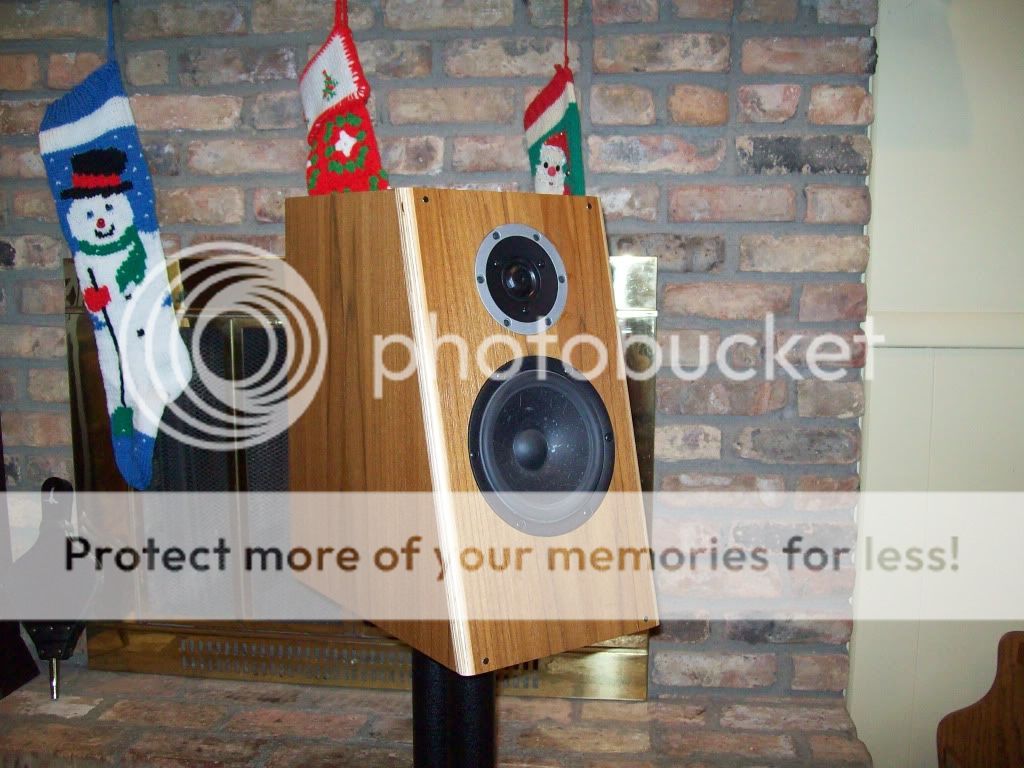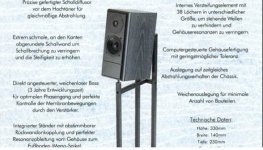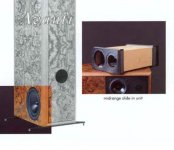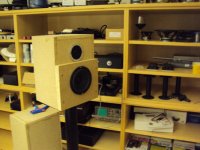Well, when you go the english way and use thin ( 9mm ) wood walls bitumen is ok.
In case of 19mm chipboard you need something stronger and ceramic tiles work very well.
You can google " constrained layer damping".
The idea is to make a sandwich where the sound can not pass through.
The complication is to define the frequency range where this should happen.
Soft : lower frequency Hard : higher frequency
In case of 19mm chipboard you need something stronger and ceramic tiles work very well.
You can google " constrained layer damping".
The idea is to make a sandwich where the sound can not pass through.
The complication is to define the frequency range where this should happen.
Soft : lower frequency Hard : higher frequency
I am building the DIY version of the cabinets for the Satori Monitors. In the meantime the professionally made cabinets are build by SB. We still have not decided if we will offer this cabinets ready made or as a flat pack.
Anyway, here i show you how to build cabinets for the Satori Monitor with minimum effort.
We decided before on a Guru clone for the shape of the cabinet.
I am building it in 19mm chipboard. That is cheap and easy to work with. Some say that it also sounds better then MDF. I think it is not worse.
The dimensions are a bit unusual but not unattractive. They are 30cm wide, 40cm high and 22,5cm deep. There is also a 32mm thick baffle made from 2 x 16mm chipboard
to time align the drivers. I will round the edges and will look if the sharp edge from the woofer baffle to the tweeter has any bad effect. The wider then usual baffle has the advantage that the baffle step is not that pronounced so we win some efficiency in the fundamental tone area. The tweeter on the wider baffle will push the edge reflexion to lower frequencies. Would be ideal if i can place the crossover point in such a way that the edge reflexion suck out is in the region where the crossover already rolls off the tweeter. The front baffle is mechanically quite stable because of the extra baffle for time alignment. That way 2/3rd of the baffle is 51mm think. The side and top walls are not very deep, that also helps to make them stiffer then usual. The biggest unbraced wall is now the back wall so i decided to glue on a ceramic tile.
Very nice to see the progress!
Interesting way of dealing with cabinet damping. I usually use bracing + bitumen in chosen places and it works reasonably well.
I've almost finished my measurements for the Satori mid-woofer and it looks nice, but I used a less wide baffle for the measurements, 25cm with a 18mm round-over (r=18). I haven't yet decided if I will use a wider baffle or not.
The mid-woofer seems quite sensitive. If my calculations are right, they have without cross-over a 89,5-90dB 2.83V/1m sensitivity in the 1.5-3kHz region.
In the frequency domain, the mid-woofers edge resonance isn't bad at all and looks much better than the official spec sheet, at least on my test baffle
Will do some distortion tests today.
Regards
/Göran
This is kind of interesting :The Renegade Tweeter Theory
I used reversed phase tweeters here and there going back to my early 90th Audio Physic designs. For example the early Step and Spark had a crossover less mid woofer and a revered tweeter with just one cap and a resistor. This designs had some problems. One of which where a suck out between mid woofer and tweeter when you stood high. To ameliorate this problem, the cabinets where placed on a special stand that angled the speakers backwards. The other was that the impulse response started negative.
I just tried to push that phenomenon as high up as possible. In result the phase response looked better then usual and this particular speakers where praised for the big sound stage they throw. In retrospect i think that this was not only a function of the crossover but also due to the rather wide dispersion. One famous company that uses reversed tweeters is Wilson Audio.
I used reversed phase tweeters here and there going back to my early 90th Audio Physic designs. For example the early Step and Spark had a crossover less mid woofer and a revered tweeter with just one cap and a resistor. This designs had some problems. One of which where a suck out between mid woofer and tweeter when you stood high. To ameliorate this problem, the cabinets where placed on a special stand that angled the speakers backwards. The other was that the impulse response started negative.
I just tried to push that phenomenon as high up as possible. In result the phase response looked better then usual and this particular speakers where praised for the big sound stage they throw. In retrospect i think that this was not only a function of the crossover but also due to the rather wide dispersion. One famous company that uses reversed tweeters is Wilson Audio.
What about building a box with for an example 8-12mm particleboard or mdf as outer layer and same or another type of wood on the inside and 10-12mm packed sand between? Like a sandwich. I've actually tested this with my own floorstanders, but only the compartment from midbass and up thus I got a big hole after replacing swans rt2-ha with Sb 29rdc. Even though it's first two 19mm mfd glued together + and extra 25mm and bitumen this can "ring" compared to now with sand in between. My knuckles hurt if i do a test. Really dead now. I think it was only around half a kilo for each.
More precise stereoimage and control, especially when played loud.
More precise stereoimage and control, especially when played loud.
This is of cause a good way to do it, especially for DIY. I found also the " box in a box " construction works great. I pioneered that in the Audio Physic Avanti from 1989.
Here i had a very well damped and braced inner box that was slided in an outer box with foam rubber gaskets. Here " Air" worked better then sand.
Here i had a very well damped and braced inner box that was slided in an outer box with foam rubber gaskets. Here " Air" worked better then sand.
Here is a picture.
You will not imagine what i tried. Granite, marble, steel, even lead.
At the end of the day when when resonances are under -40dB they should be inaudible because of masking. Some may think different. Listening to an open dipole or headphones is a good reality check.
You will not imagine what i tried. Granite, marble, steel, even lead.
At the end of the day when when resonances are under -40dB they should be inaudible because of masking. Some may think different. Listening to an open dipole or headphones is a good reality check.
Attachments
Thx for valuable info Joachim. Didn't know that. I have seen those models before but didn't know the background with all this ideas.
I got the idea of sand a day at the boxing gym when i hit the bag really hard without gloves and the same week I tested to fill my empty pipes in my stereo bench with sand and i got really excited. Then I started to read more and more in various Hifi magazines that many speakers have a empty compartment in the bottom (floorstanders) ok, mass gets higher but i don't think it's help a crappy box to become suddenly "hifi".
One thing I've always wanted to test is to have a separate compartment for the x-over and when x-over tweaking is over, -fill it up with sand also. Have you tested this? That have to lower microfoni to a very low level.
Have you seen Albert Von Schweikert triple wall?
A Whitepaper: The Audibility Of Cabinet Panel Resonances and Pat. Pend. Method Of Reduction Of Audible Coloration - Spotlight - Dagogo
I got the idea of sand a day at the boxing gym when i hit the bag really hard without gloves and the same week I tested to fill my empty pipes in my stereo bench with sand and i got really excited. Then I started to read more and more in various Hifi magazines that many speakers have a empty compartment in the bottom (floorstanders) ok, mass gets higher but i don't think it's help a crappy box to become suddenly "hifi".
One thing I've always wanted to test is to have a separate compartment for the x-over and when x-over tweaking is over, -fill it up with sand also. Have you tested this? That have to lower microfoni to a very low level.
Have you seen Albert Von Schweikert triple wall?
A Whitepaper: The Audibility Of Cabinet Panel Resonances and Pat. Pend. Method Of Reduction Of Audible Coloration - Spotlight - Dagogo
I never brought commercial speakers to the market that have the crossover being cast or put in sand.
In separate compartments, yes, outside the box when testing the prototype, yes.
The main reason is that i want the crossover repairable. From the 10.000nds speakers i sold world wide very few came back with destroyed crossovers but sometimes it happened. The most bad example was a Virgo where the woofer cones had started burning and some parts of the crossover had gotten so hot that they desoldered themselves. I found that the customer had thrown a big party in a huge barn and had used one of the biggest Krell amps for hours.
The interesting thing is that i did not discuss this casting option much with other designers over the 30 years that i am a professional. The only longer communication was with John De´Vore. He told me that he could here differences but after tuning both types of crossovers he could make them sound more or less the same so he has given up on casting. Recently i am talking a lot to Michael Boerresen, but that is more how to make passive parts more compact and rigid.
This 3 wall sandwich also makes sense to me. There are many ways to Rome.
In separate compartments, yes, outside the box when testing the prototype, yes.
The main reason is that i want the crossover repairable. From the 10.000nds speakers i sold world wide very few came back with destroyed crossovers but sometimes it happened. The most bad example was a Virgo where the woofer cones had started burning and some parts of the crossover had gotten so hot that they desoldered themselves. I found that the customer had thrown a big party in a huge barn and had used one of the biggest Krell amps for hours.
The interesting thing is that i did not discuss this casting option much with other designers over the 30 years that i am a professional. The only longer communication was with John De´Vore. He told me that he could here differences but after tuning both types of crossovers he could make them sound more or less the same so he has given up on casting. Recently i am talking a lot to Michael Boerresen, but that is more how to make passive parts more compact and rigid.
This 3 wall sandwich also makes sense to me. There are many ways to Rome.
Last edited:
During the next two days i will make the speakers work and present a crossover.
Joachim,
I am interested to see what you come up with. I received a set of Satori drivers last January and designed a speaker that was time and phase accurate with very flat frequency response. I showed the speaker at a DIY show in April and then at the MWAF in Dayton in July, but I had to wait on the new tweeter faceplate before I could release the kit. We will have the kit up very soon at Meniscus.
I am very pleased with this speaker and it is both one of the best measuring and sounding speakers I have worked with in a long long time. Within its bandwidth it has nearly transient perfect response. I have called the speaker the "Kairos", an ancient Greek word that means, among other things, "perfect timing". Here's a pic of final design.
Jeff Bagby

That looks very good !
Would you like to share the crossover schematic ?
I designed it as a commercial kit for Meniscus, so I can't release the crossover publicly, it's part of the kit. I used a self-derived asymmetrical transient perfect crossover - where the tweeter is rolling off 3rd order, the woofer shallower, and the delay in the cabinet helps achieve a summation that is still flat and nearly perfectly minimum phase. I have expermented with computer models of this type of system for several years, but the Satori drivers gave me the necessary wide flat bandwidth to pull it off in real loudspeaker.
I may post some measurements later though.
I found these drivers exceptionally nice to work with - very clean and well-behaved, and easy to achieve target response curves with.
Yes, they are very wide band and that gives a lot of options.
I mentioned before that i will try 2, maybe 3 varieties.
One will be an L/R4 for reference and because it is well established.
The only crossover that is really linear phase is first order but as you say a good approximation can be arrived at with steeper crossovers.
You roll off the tweeter 3rd order and the woofer shallower. There is also the other option to roll the woofer with a higher order Bessel and the tweeter with first order.
I think that was done by Spica. If you accept small frequency response ripples there is a second order option. I think i have seen that on the Music and Design web page.
I have also experimented with inverting the tweeter or the woofer. That also gave some interesting designs. When we go active there is the delay derived crossover or with DSP we have another plethora of possibilities but i would like to stay passive here.
I even thing that a 3rd order Butterworth is not that bad because it does not have a drop in sound power in the crossover region that the LR/4 has.
A problem with phase linear crossovers can be considerably lobing so i am very intested in your measurements, also how they look vertically.
I mentioned before that i will try 2, maybe 3 varieties.
One will be an L/R4 for reference and because it is well established.
The only crossover that is really linear phase is first order but as you say a good approximation can be arrived at with steeper crossovers.
You roll off the tweeter 3rd order and the woofer shallower. There is also the other option to roll the woofer with a higher order Bessel and the tweeter with first order.
I think that was done by Spica. If you accept small frequency response ripples there is a second order option. I think i have seen that on the Music and Design web page.
I have also experimented with inverting the tweeter or the woofer. That also gave some interesting designs. When we go active there is the delay derived crossover or with DSP we have another plethora of possibilities but i would like to stay passive here.
I even thing that a 3rd order Butterworth is not that bad because it does not have a drop in sound power in the crossover region that the LR/4 has.
A problem with phase linear crossovers can be considerably lobing so i am very intested in your measurements, also how they look vertically.
Here Göran has made some detailed measurements on the Satori mid-woofer :www.audioexcite.com SB Acoustics “Satori” MW16P-4
I find it quite amazing that the distortion profile does not change much over level.
The graphs at 85dB and 95dB look very similar.
I find it quite amazing that the distortion profile does not change much over level.
The graphs at 85dB and 95dB look very similar.
I have now build the test cabinets and have mounted the woofer and tweeter.
So far without sinking then in and without rounding or chamfering the edges.
I will measure them this way to find out what that does to the frequency response. I will then design a first crossover.
So far without sinking then in and without rounding or chamfering the edges.
I will measure them this way to find out what that does to the frequency response. I will then design a first crossover.
- Home
- Vendor's Bazaar
- SB Acoustics Satori Monitor


